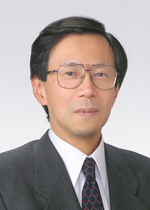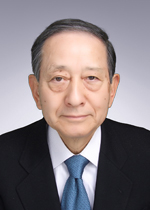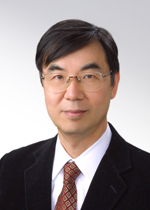The Japan Academy announced that it would award the 102nd Japan Academy Prize (2012) to Professor Fumihiko Sato (Graduate School of Biostudies), Professor Emeritus Hidehiko Kumagai, and Visiting Professor Shimon Sakaguchi (Institute for Frontier Medical Sciences). The highest of its kind within Japanese academia, the prize is awarded for outstanding research achievements in the area of scholarship.
The award ceremony will be held in Tokyo in June 2012.
Professor Fumihiko Sato (Graduate School of Biostudies) and Professor Emeritus Hidehiko Kumagai
 Professor Sato |
 Professor Emeritus Kumagai |
Professor Sato was born in 1953. After withdrawing from the doctoral program at Kyoto University's Graduate School of Agriculture, he successively served as an associate professor at the Faculty of Agriculture, professor at the same faculty, and professor at the Graduate School of Agriculture before being appointed to his current position as professor at the Graduate School of Biostudies in April 1999. He is an expert in plant cell molecular biology.
Professor Emeritus Kumagai was born in 1940. After completing the doctoral program at Kyoto University's Graduate School of Agriculture, he successively served as associate professor at the Faculty of Agriculture, professor at the same faculty, professor at the Graduate School of Agriculture, and professor at the Graduate School of Biostudies before being conferred the title of professor emeritus at Kyoto University in April 2004. Beginning in April 2004, he was a professor at Ishikawa Agricultural College and professor at Ishikawa Prefectural University. In 2011, he was conferred the title of professor emeritus at Ishikawa Prefectural University. Since April 2011, he has served as a specially-appointed professor at that university. His field is applied microbiology.
Plant secondary metabolites are used in a variety of applications, including drugs and flavoring agents. There are, however, many problems in terms of production capacity, quality variation and resource supply. Professor Sato and Professor Emeritus Kumagai were the first researchers in the world to successfully produce typical plant secondary metabolites called isoquinoline alkaloids using microbes. Professor Sato established cultivation cells that can efficiently produce isoquinoline alkaloids from plants, such as a medicinal plant called coptis japonica; discovered the functions of many enzymes governing the biosynthesis of isoquinoline alkaloids; and isolated those genes that are involved. Professor Emeritus Kumagai, on the other hand, analyzed the metabolism of aromatic amino acids and amines necessary for the synthesis of isoquinoline alkaloids regarding many microbes, and established a basis for the bacterial biosynthesis of isoquinoline alkaloids. They then introduced into E. coli bacteria the gene involved in isoquinoline alkaloid biosynthesis, which was isolated by Professor Sato from coptis japonica, and the gene necessary for producing the isoquinoline alkaloid precursor, which was discovered by Professor Emeritus Kumagai. As a result, they successfully produced reticulin, a key substance in the biosynthesis of isoquinoline alkaloids, which is based on a cultivation process using glucose as the only carbon source--something that no one in the world had done before. These accomplishments have pioneered a new path toward commercial production of plant secondary metabolites using microbes by fusing the metabolic systems of higher plants and microbes, and made quite a significant contribution to the development of a new field of metabolic engineering. They have also offered a new approach of great social value for realizing the stable supply of useful secondary metabolites, which normally involves problems regarding productivity and procurment of resources.
Shimon Sakaguchi (Visiting Professor, Institute for Frontier Medical Sciences)

Professor Sakaguchi graduated from Kyoto University's Faculty of Medicine in March 1976, enrolled in the Graduate School of Medicine in the same year, and was awarded a medical doctor's degree from Kyoto University in November 1983. After graduation, he served as a doctor at the Kyoto University Hospital and later as a faculty member and researcher at Johns Hopkins University, Stanford University and the Scripps Research Institute in the US. He was then appointed as full-time researcher at PRESTO (Precursory Research for Embryonic Science and Technology) by the Research Development Corporation of Japan in March 1992, leader of the immunopathology department at the Tokyo Metropolitan Institute of Gerontology in April 1995, professor at Kyoto University's Institute for Frontier Medical Sciences in February 1999, and director of the Institute for Frontier Medical Sciences in October 2007. He was appointed to his current position as professor at Osaka University’s Immunology Frontier Research Center (one of the World Premier International Research Centers) in April 2011, while also serving as a visiting professor at Kyoto University's Institute for Frontier Medical Sciences.
The prize is to be awarded for his research involving immune response control by regulatory T-cells. Our immune system responds to viruses and bacteria, but it neither responds to nor hurts the body's own normal tissues. How the immune system's non-response to normal autoantigens, or "self-tolerance," is established and maintained in a normal individual had been an important issue to solve for modern immunology and medicine. It was Professor Sakaguchi who discovered regulatory T-cells as an essential mechanism for self-tolerance and immune control, and who demonstrated before any other researchers in the world that they suppress abnormal, excessive or pathological immune responses. He also found that abnormality in the genesis or functionality of regulatory T-cells causes a variety of immune diseases. In addition, he discovered the mechanism of genesis and suppression of regulatory T-cells at the cellular and molecular levels. At the same time, the control of regulatory T-cells has greatly helped in the development of methods for controlling autoimmune diseases and allergies, for introducing immunological tolerance to transplanted organs, and for inducing immunological responses to cancer cells.

